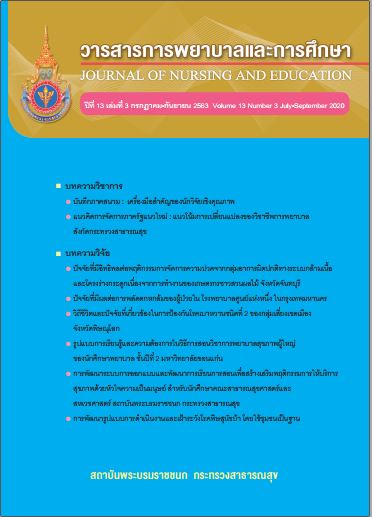ปัจจัยที่มีผลต่อการพลัดตกหกล้มของผู้ป่วยใน โรงพยาบาลศูนย์แห่งหนึ่ง ในกรุงเทพมหานคร
Factors Influencing for Falls of In-Patients at a Regional Hospital in Bangkok Metropolis
คำสำคัญ:
การพลัดตกหกล้ม, ผู้ป่วยใน, ภาวะโรคร่วมบทคัดย่อ
การวิจัยนี้มีวัตถุประสงค์เพื่อศึกษาปัจจัยที่มีผลต่อการพลัดตกหกล้มของผู้ป่วยในของโรงพยาบาลศูนย์
แห่งหนึ่งในกรุงเทพมหานคร กลุ่มตัวอย่าง คือ เวชระเบียนผู้ป่วยใน ระหว่างปี 2557-2560 รวม 175 ฉบับ
ประกอบด้วยเวชระเบียนที่พบอุบัติการณ์พลัดตกหกล้มและมีใบรายงานอุบัติการณ์ที่มีข้อมูลครบถ้วน 76 ฉบับ
และเวชระเบียนที่ไม่พบอุบัติการณ์พลัดตกหกล้ม 99 ฉบับ เครื่องมือที่ใช้ในการวิจัย คือ แบบบันทึกข้อมูล
ปัจจัยที่มีอิทธิพลต่อการพลัดตกหกล้มของผู้ป่วยในโรงพยาบาลที่ผู้วิจัยสร้างขึ้น ตรวจสอบความตรงตามเนื้อหา
โดยผู้ทรงคุณวุฒิ 3 คน มีค่าดัชนีความสอดคล้องของเนื้อหา เท่ากับ 1.00 วิเคราะห์ข้อมูลด้วยสถิติเชิงพรรณนา
และการวิเคราะห์ถดถอยโลจิสติกส์แบบทวิ
ผลการวิจัยพบว่า ผู้ป่วยที่มีอุบัติการณ์พลัดตกหกล้มเกินกว่าครึ่งหนึ่ง (ร้อยละ 56.6) อยู่ในช่วงอายุ
มากกว่า 60 ปี ร้อยละ 94.7 ไม่มีประวัติการพลัดตกหกล้มภายใน 1 ปี ผู้ป่วยทุกคนมีภาวะโรคร่วม ร้อยละ
82.9 ได้รับการประเมินความเสี่ยงต่อการพลัดตกหกล้มเมื่อแรกรับ เกิดการพลักตกหกล้มในช่วงเวรเช้ามาก
ที่สุด ร้อยละ 31.1 โดยร้อยละ 50 เกิดการพลัดตกหกล้มที่ข้างเตียง หลังการเกิดอุบัติการณ์ ผู้ป่วยร้อยละ53.9 ไม่บาดเจ็บแต่ต้องเฝ้าระวังอาการเปลี่ยนแปลงอย่างใกล้ชิด ปัจจัยที่มีอิทธิพลต่อการพลัดตกหกล้มของ
ผู้ป่วยในอย่างมีนัยสำคัญทางสถิติที่ระดับ 0.05 ได้แก่ภาวะโรคร่วมทางระบบประสาทและสมอง (OR 2.96;
95%CI: 1.11 - 7.89) ภาวะโรคร่วมของระบบกระดูกและกล้ามเนื้อ (OR 2.45; 95%CI: 1.20- 5.01) และ
ภาวะโรคร่วมทางระบบหัวใจและหลอดเลือด (OR 0.49; 95%CI: 0.25- 0.94)
สรุป: ผลการศึกษานี้สามารถ ใช้เป็นแนวทางในการพัฒนาแนวปฏิบัติในการเฝ้าระวังการพลัดตกหกล้ม
ของผู้ป่วยในโรงพยาบาล โดยให้ความสำคัญกับการเฝ้าระวังและป้องกันการพลัดตกหกล้มในผู้ป่วยที่มีภาวะ
โรคร่วมทางระบบประสาทและสมองและ ระบบกระดูกและกล้ามเนื้อ
เอกสารอ้างอิง
A Synthesis of Research on Fall Prevention
and Management in Hospitalized Patients.
Rama Nursing Journal. 2011; 17(1): 108-125.
(In Thai).
2. World Health Organization, WHO Global Health
Estimates database [online]. 2018[cited
2020/05/16 ]. Available from: https://www.
who.int/news-room/fact-sheets/detail/falls
3. The Joint Commission International, Summary
Data of Sentinel Events Reviewed by The Joint
Commission. 2012. Available from: http://
www.jointcommission.org/assets/1/18/
2004_4Q_2012_SE_Stats_ Summary.pdf.
4. Ganz D. A. Berlowitz D. Preventing Falls in
Hospitals A Toolkit for Improving Quality of
Care. Agency for Healthcare Research and
Quality Publication :2013.
5. The National Safety and Quality Health Service
(NSQHS) Standards Provide a Nationally Consistent Statement of the Level of Care Consumers Can Expect from Health Service Organizations. Australian Commission on Safety
and Quality in Health Care: 2011.
6. The Healthcare Accreditation Institute (Public
Organization). Patient Safety Goals: SIMPLE
Thailand 1ed. 2018: 119-121.
7. Medical Record and Statistics Section, Annual Statistics Report 2017. Information Technology Division. Rajavithi Hospital. Retrieved at
20/3/2563 from http://intranet.rajavithi.go.th/
news_raja/index.php?mode=topicshow&tp_
id=164731 (In Thai).
8. Tamee R, Chaipibansarit P, Apiraknapanon P,
Relationship between the Selected Factors and
Inpatient Fall in Private Hospital. Vajira Nursing
Journal. 20 (1):12-26. 2018. (In Thai).
9. hao YL, Kim H, Older Adult Inpatient Falls in
Acute Care Hospitals: Intrinsic, Extrinsic, and
Environmental Factors. J Gerontol Nurs.
2015;41:29-43.
10. Loria G, Bhargava A, Prevention of Patient
Falls eA Case Study. Apollo Medicine 2013;
10 (2):175–180.
11. Tontrong T, Yamwong N, Kongsakorn N, and
Deenok S, Development Guide Line to Risk
Evaluation for Preventive Falls in Patient at
in-Patient Department. Srinakharinwirot university. 2010. (In Thai).
12. Kanchanawasi S, Assessment Theory. 9thed.
Chulalongkorn University Press; 2019. (In
Thai).
13. Lecktip C, Woratanarat T, Bhubhanil S, &
Lapmanee S, Risk Factors for Falls in Elderly.
Journal of Medical and Health Sciences.
2019;26(1):85-103. (In Thai).
14. Papol A, Ramkhuan C, & Pinnoi W, A Study
of Fall Risk in Stroke Patients after Hospital
Discharge. Journal of The Royal Thai Army
Nurses. 2019; Supplement: 194-201.
15. Salamon LA., Victory M., Bobay K, Identification of Patients at Rick for Fall in an Inpatient
Rehabilitation Program. Rehabil Nurs 2012;
37(6):292-7. 2012;37(6):292-297.
16. Tengnoi W,, Sangwanthong V., Phongphanich
P. & Prakob N, Compare of Falls Incidence
among Patients with Different Risk Levels at
Jainad Narendra Hospital. Research Report.
[online]. 2018 [cited 2019/08/31 ]. (In Thai).
Available from: http://www.chainathospital.org/
chainatweb/research/viewdownload/4
17. Christman M., Morse J., Wilson C., Godfrey
N. Doig A., Bloswick D. et al, Analysis of the
Influence of Hospital Bed Height on Kinematic Parameters Associated with Patient Falls
During Egress. Science Direct. 2015; 280-
287.
18. Tiyapanit C, Tangwongchai S, Champaiboon
J. Prevalence and Fall Risk in Mild Cognitive
Impairment and Dementia at Outpatient Clinics, Chulalongkorn Hospital. Chulalongkorn
Medical Journal. 2018;62(5):799-813. (In
Thai).






